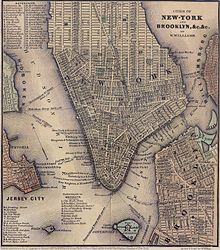New York and Harlem Railroad
The New York and Harlem Railroad was an American railroad company that opened the world's first streetcar line in New York City in 1832 .
history
The company was founded in 1831. The face value of a share in the New York and Harlem Railroad was $ 50. The railway initially operated a stretch of mule- drawn wagons across Manhattan. But since the mules quickly turned out to be unprofitable, a steam locomotive was used . When there was a serious accident in Union Square with one dead and twenty injured, the angry mob tore the rails there and forced the company to shut down steam operations. So horses were used for the further operation.
In 1863 the company was taken over by the railroad baron Cornelius Vanderbilt . After holding shares in the company for several years, he began to buy more shares in 1862 and was appointed managing director of the company in May 1863. In 1873 the railway was switched to cable operations, as is still the case in San Francisco today . Since the horses , unlike the mules, cannot be taught to leave their faeces in certain places, the railways began to be switched to electrical operation in 1893. But since only underground power rails were allowed in New York, the last horse-drawn trams lasted until 1915 due to the high conversion costs.
When then Mayor Fiorello LaGuardia got stuck behind a stuck train in a narrow street on one of his frequent trips with the fire department in Brooklyn in 1936, he vowed to make New York “tram free”. In 1956 the last tram left Jersey City over the George Washington Bridge .
Route
The steam-powered trains on the New York and Harlem Railroad reached New York City from the north. The route through Manhattan ran on Fourth Avenue to 42nd Street . Then she passed under Murray Hill in a tunnel before the trains ended at the company's depot on Twenty-sixth Street. There, passengers were able to transfer to horse-drawn carts that ran across the Bowery to New York City Hall .
Web links
- Harlem Railway Affair (English)
